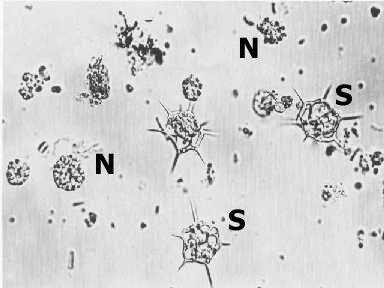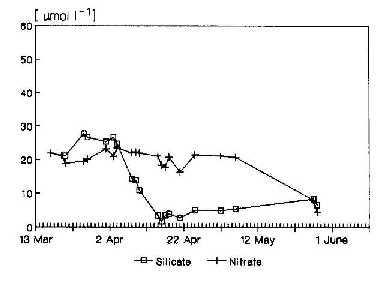|
Navigation
Home
Science
Publication List
Public Writing
Texas Special
E-Mail
|
|
Naked Dictyocha speculum - a new type of phytoplankton bloom in the Western Baltic
by
Frank J. Jochem and Birgitta Babenerd
published in
Marine Biology vol. 103, p. 373 - 379; 1989

|
Objective
Since the early 1980's exceptional phytoplankton
blooms seem to have increased in number and size in German, Danish and
Swedish waters. It is now apparent, from long-term trend analysis, that
in all regions, annual inputs of phosphorus and nitrogen have increased
by a factor of about three during the past three decades, and that overall
biomass production has increased by the same order of magnitude. Nevertheless,
it is still uncertain whether there is any direct causative relationship
between elevated nutrient inputs and the more frequent occurrence of so-called
exceptional phytoplankton blooms. Phytoplankton bloom formation depends
not only on the supply of nutrients (although this is the main prerequisite
for high biomass) but also on a variety of other environmental factors
such as light availability and the absence or the ineffectiveness of grazers
There can be no doubt that over the past
decade blooms of newly reported, undesirable species have increased in
the Baltic transitional area, including Kattegat and Skagerrak. Examples
are Gyrodinium aureolum, Prorocentrum minimum, and Chrysochromulina
polylepis. In the Kiel Bight, P. minimum has formed blooms annually
since 1983 during August/September and thus became a normal component of
annual phytoplankton succession.
A similar development has taken place
with a new type of phytoplankton bloom which is the main subject of this
paper: the naked form of the silicoflagellate Dictyocha speculum
(syn. Distephanus speculum). Blooms of this organism first occurred
in the Kiel Bight area in May 1983 and have also become common in the species
succession of this area.
The first records came from the Danish
Alssund where a bloom of naked, previously undescribed flagellates was
observed in connection with heavy mortalities of caged fish. It was identified
by Moestrup and Thomsen (H. Thomsen, Copenhagen, personal communication)
as a naked, (i.e., non-skeleton-forming) modification of Distephanus
speculum and was confirmed by observations in Kiel Bight.
Silicoflagellates of the genus Dictyocha
are marine chrysophytes bearing a single flagellum and a star-shaped
siliceous skeleton composed of tubular elements forming a basal ring and
several extruding spines. While D. fibula possesses a quadrangular
basal ring and four spines, D. speculum, which is to be found in
the Kiel Bight area, has a hexagonal basal ring and six spines.
Results
Naked cells of Dictyocha speculum
found in Kiel Bight are more or less spherical and ca. 20 µm in diameter
(Fig. 1). They possess one flagellum and ca. 25 chloroplasts. The cell
surface often appears to be lobed due to plastids and cells are very sensitive
to high temperatures and physical stress (e.g. shaking). In preserved samples,
they easily disintegrate after brief storage. The flagellum is mostly shed
upon preservation.
|

|
Fig.1: Since the early 1980's, besides typical skeleton-bearing forms
(S) of Dictyocha speculum, naked forms (N) form massive blooms in
May. Cell numbers rise to several millions per liter. Fish death related
to theses blooms were reported from Danish waters but could not be confirmed
in Kiel Bight
In Kiel Bight, D. speculum exhibited a
bloom period of ca. 20 days with maximum cell numbers ~6-7 million cells
per liter.
There are good reasons to believe that
the persistent occurrence of this new late-spring flagellate bloom is related
to changed nutrient conditions due to eutrophication, especially the input
of inorganic nitrogen compounds.
The annual cycle of phytoplankton succession
in the Kiel Bight area starts with a massive diatom bloom in March/April.
At least until the mid-1970's this typical diatom bloom was terminated
by the exhaustion of inorganic phosphorus and/or nitrogen compounds while
small amounts of silicate were still available. Nowadays, however, lack
of silicate seems to terminate the diatom spring bloom, and the
remaining nitrate and phosphate
are apparently sufficient to support considerable blooms of silicate-independent
flagellates in May - among them increasingly unusual and harmful species.
To verify this hypothesis, we followed
the change in nitrate and silicate concentrations in inner Kiel Fjord during
spring 1984, 1986, and 1988 (the years of naked D. speculum blooms).
Whereas silicate was low at the onset of the D. speculum blooms,
nitrate concentrations were still consideralbe (Fig. 2). From natural water
samples, Redfield gave an atomic Si:NO3 ratio of 0.94.
|

|
Fig 2: Silicate (squares) and Nitrate (crosses) concentrations in spring 1984
Ratios in Kiel Fjord in April and May 1984, 1986, and 1988 were below 1.0 for
both surface and subsurface waters and thus indicate silicate rather than
nitrate to have been the limiting nutrient.
Comparing nutrient data from 1939 to those
of the D. speculum bloom years reveals: Silicate conentrations in
March were similar in all years. But compared to 1939, values below 8 µmol
l-1 were reached 20 days earlier in the
season in 1986 and 1988 and even 30 days earlier in 1984.
Furthermore, data analysis revealed a decreasing trend in winter concentrations
of silicate since the mid 1970's (r =-0.63, p < 0.05, n = 17). Consequently,
silicate limitation of diatom spring blooms should become more evident as long as
anthropogenic nitrogen input into the Baltic Sea commences - thus increasing favorable
growth conditions for flagellate blooms in May.
Similar trends of decrasing silicate concentrations
and a shif in the nutrient composition have been reported from the adjacent
Arkona Sea, the Skagerrak and the German Bight.
In Kiel Bight, D. speculum not only demonstrates that an 'exceptional'
bloom may become a recurrent event
in the annual special succession but may also be related to the change
in environmental conditions due to eutrophication. Although known for years
to occur in Kiel Bight as a skeleton- forming species, D. speculum
had never built blooms as naked forms before. Thus, changed environmental
conditions stimulated this species to grow in a yet unknown form.
|
|
Credits
 This work was performed at the Institut
für Meereskunde Kiel, Germany.
This work was performed at the Institut
für Meereskunde Kiel, Germany.
References
Jochem, F. & B. Babenerd: Naked Dictyocha
speculum - a new type of phytoplankton bloom in the Western Baltic. Marine
Biology 103, 373-379. 1989
You may also download the whole paper
as PDF file
|
|


